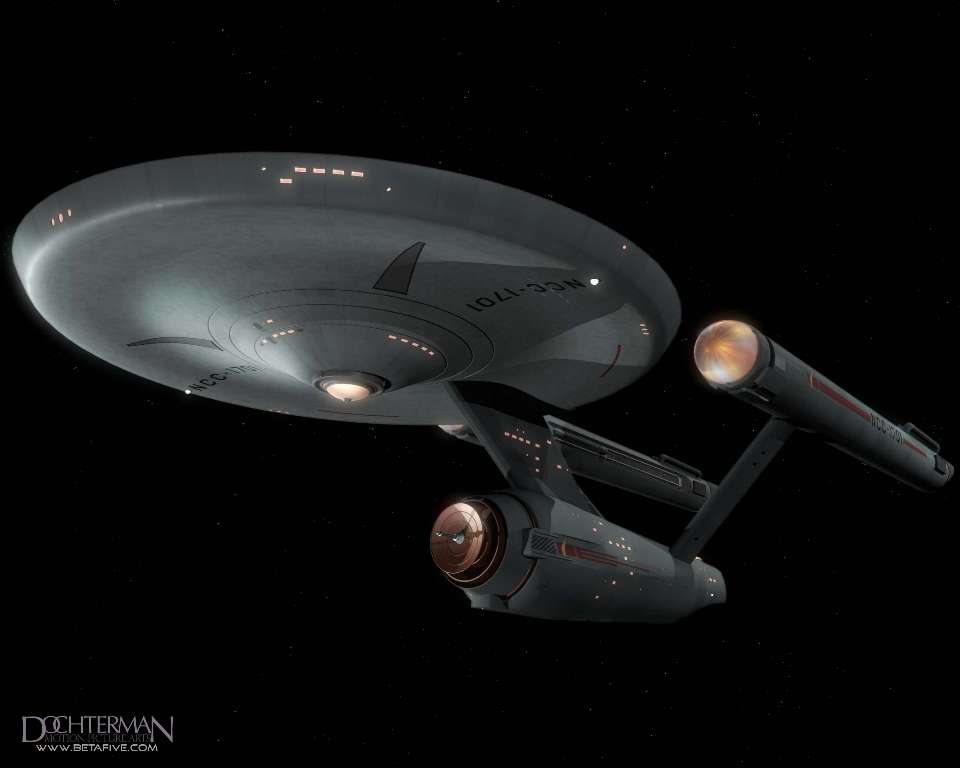Cary L. Brown said:
I'll never wrap my head around why some people keep saying this (about the Enterprise "not looking good on screen"). I'm sorry, it's just utter NONSENSE.
My old issues of "Starlog" are boxed away somewhere in my mom's house 1000 miles away, but I distinctly remember Mike Minor saying (paraphrasing from distant memory) that some added detail was necessary for the big screen. He didn't want to make it a "Star Wars" ship, but it needed more visual interest.
Nobody who's doing a WWII movie ... at least nobody COMPETENT... thinks "Well, that WWII-era aircraft carrier doesn't look good... I'd better put some flourescent panels on it in bright primary colors... otherwise it'll look bad on-screen." DO THEY?
Well, we know what a WWII era aircraft carrier should look like, though.
The folks doing this movie MIGHT decide to take liberties with the 1701's design. I doubt it, but they might. But even if they do, that couldn't be attributed to "the design not being good." It might be attributable to all variety of other legal, moral, or business reasons... (ie, the "artists" wanting to have their own take on it?). But I can think of NO technical rationale for why the ship design "must" be altered in order for it to "look good."
It's not about the design "not being good," or anything like that. The basic look is beautiful. But, it's about taking something that was designed to be seen on 25-inch TV screens and giving it the necessary details to make it look "real" when it's 25-feet tall. That's the whole point, really. The design is great, whether it's TMP NCC-1701 or TOS NCC-1701. It's about VISUAL INTEREST up close. Seams, variances in paint, little details like sensors, tubes, weapons bays, shuttle docks, elevators and such.
Can ANYONE give a true, rational argument for why they think this is the case? Other than these (which are NOT rational or logical):
I gotta get in the car and drive 1000 miles to find my summer and fall 1979 issues of "Starlog". Mike Minor had an answer.
Roddenberry required the new look to be rationalized as a refit Enterprise. But there's no way that ship could be the TOS ship merely refit. The saucer is bigger and has different curves. The lower hull is a completely different shape. The neck is very different. These are NOT just modifications or such. The proportions are too different.
In reality, this is a BRAND NEW design based on the basic shape of the older design. Calling TMP Enterprise merely a refit version of TOS Enterprise is like saying a Nextel Cup car is merely a refit street car.
Of course, Roddenberry required the change in look to have an on screen explanation, so there you go. It's a refit.
1) "Dude, it has a satellite dish on it."
This sort of argument is typically made by kiddies who have no actual scientific/technical knowledge whatsoever, but who grew up in the TNG "brightly illuminated primary color panels equals kewl technology"
I won't bore the rest of you with another diatribe on why parabolic reflectors are made in parabolic form, with a receptor or emitter at the focii of the dish... but suffice it to say it's REAL SCIENTIFIC PRINCIPLES AT WORK.
Everyone knows why the dish is shaped like it is. Except today, almost everyone has a dish. I don't have a big issue with the dish on the front of TOS Enterprise, but to some, as it looks, all it may be missing is the DirecTV or Dish logo. Frankly, I'm in the camp that believes how the dish was designed for TMP Enterprise was better.
2) "The ship needs more details... it's too plain, and that's boring."
This is caused by kids who grew up on Star Wars and assume "guts on the outside" means realistic.
This was a stylistic choice made by Lucas's folks on the first movie (based in part upon choices made by Trumbull's stuff in 2001).
The Star Trek philosophy, created by Matt Jeffries and consistent with REAL LIFE design principles... is that if you have a choice of having a piece of hardware inside of the ship... in a "shirt sleeves" environment... or outside the ship (where you need a space suit just to perform routine maintenance)... the obvious choice is to put it on the inside. It's just common sense, really...
It's a question of economics, really. If it would be cheaper to design a ship that required an occasional spacewalk (a very routine event) in order to do maintenance, so be it. A smooth skin is totally unnecessary in space.
Roddenberry wanted the Enteprise to look powerful and look like a starship, not something meant for atmospheric flight. But the for most the greater aesthetic appeal is for "smooth" over "rough," so the Enterprise is smooth even if it's not aerodynamic.
But in reality, even if hardware is placed inside the ship, that doesn't mean it has to have graceful curves and a smooth-and-tight-as-a-baby's-bottom skin.
3) "The ship design is too fragile."
Well, by that argument EVERY ship we've seen in Trek, and the majority we've seen in any other show, are all "too fragile." Without knowing the exact strength of the components, and the exact maximum loads they were designed to bear, it's impossible to say that anything is "too weak."
Never heard that one before. Anyone who knows that it's a space ship wouldn't really think that, either. I've always thought the ship showed both grace and strength.




